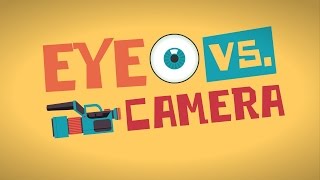(单词翻译:单击)
Watch the center of this disk. You are getting sleepy.
盯着这个圆盘的中心看。你会感到昏昏欲睡。
No, just kidding. I'm not going to hypnotize you.
没有啦,开玩笑的。我不准备去催眠你。
But are you starting to see colors in the rings?
但是你开始看见这些环中间的颜色了吗?
If so, your eyes are playing tricks on you.
如果是的话,你的眼睛在欺骗你。
The disk was only ever black and white.
这个圆盘一直以来就是黑白的。
You see, your eyes don't always capture the world as a video camera would.
你看,你的眼睛不总是像摄影机那样捕捉这个世界的。
In fact, there are quite a few differences,
实际上,它们之间有不少的区别,
owing to the anatomy of your eye and the processing that takes place in your brain and its outgrowth, the retina.
在于眼睛的结构,在大脑中发生的处理过程,还有它的副产物,视网膜。
Let's start with some similarities.
让我们从一些相似点开始说起。
Both have lenses to focus light and sensors to capture it, but even those things behave differently.
两者都有用于聚光的透镜和捕捉光的传感器,但是它们也会表现的不一样。
The lens in a camera moves to stay focused on an object hurtling towards it,
摄像机中的透镜移动,去聚焦一个向它急速运动的物体。
while the one in your eye responds by changing shape.
然而,眼睛中的透镜(水晶体)会对于形状的改变有所反应。
Most camera lenses are also achromatic, meaning they focus both red and blue light to the same point.
大部分摄像头的镜头是无色的,所以它们将红蓝光都聚焦在同一个点。
Your eye is different. When red light from an object is in focus, the blue light is out of focus.
你的眼睛则不一样。当一个物体上的红光被聚焦了,蓝光就不受聚焦了。
So why don't things look partially out of focus all the time?
为什么事物不是永久的,部分不受聚焦呢?
To answer that question, we first need to look at how your eye and the camera capture light: photoreceptors.
为了回答这个问题,我们先需要看一下你的眼睛和摄像头分别是如何捕捉光的:感光器。
The light-sensitive surface in a camera only has one kind of photoreceptor that is evenly distributed throughout the focusing surface.
在一个摄像头内,感光表面只有一种平均分布于聚焦表面的感光器。
An array of red, green and blue filters on top of these photoreceptors
一束结合了红,绿,蓝的光束在感光器上被过滤,
causes them to respond selectively to long, medium and short wavelength light.
造成它们有选择性地对长、中、短波长的光作出反应。
Your eye's retinas, on the other hand, have several types of photoreceptors,
你眼睛的视网膜则有多种感光器,
usually three for normal light conditions, and only one type for lowlight, which is why we're color blind in the dark.
通常有三种用于常光条件,只有一种用于低光,这也是为什么我们在黑暗中会色盲。
In normal light, unlike the camera, we have no need for a color filter
在常光中,不像摄像头,我们的眼睛不需要一个颜色过滤器,
because our photoreceptors already respond selectively to different wavelengths of light.
因为我们的感光器已经选择性地对不同波长的光作出了反应。
Also in contrast to a camera, your photoreceptors are unevenly distributed,
与摄像头相反的点,还有你的感光器是不平均地分布的,
with no receptors for dim light in the very center.
在中心,不存在接收暗光的感光器。
This is why faint stars seem to disappear when you look directly at them.
这也是为什么晕星在当你直视它们的时候似乎消失了。

The center also has very few receptors that can detect blue light,
中心有少数可以探测蓝光的接收器,
which is why you don't notice the blurred blue image from earlier.
这也是为什么你不会注意到早前模糊的蓝光。
However, you still perceive blue there because your brain fills it in from context.
然而,你仍旧会感知到蓝色,因为你的脑子将它从环境中填进。
Also, the edges of our retinas have relatively few receptors for any wavelength light.
同时,我们视网膜的边缘也有较少的针对任何波长光的接收器。
So our visual acuity and ability to see color falls off rapidly from the center of our vision.
所以我们对看见颜色的灵敏度和能力从我们视觉中心快速地下降。
There is also an area in our eyes called the blind spot where there are no photoreceptors of any kind.
在我们的眼睛中,还有一个叫做盲点的区域,那里没有任何的感光器。
We don't notice a lack of vision there because once again, our brain fills in the gaps.
在那里,我们无法察觉到视力的缺乏,因为我们的大脑再一次地填充之间的空白。
In a very real sense, we see with our brains, not our eyes.
就此而言,我们是用我们的大脑在看,而不是眼睛。
And because our brains, including the retinas, are so involved in the process, we are susceptible to visual illusions.
而且因为大脑,包括视网膜,在这个过程中涉入了太多,我们是易受视觉错觉影响的。
Here's another illusion caused by the eye itself.
这是另一个由眼睛自身产生的错觉。
Does the center of this image look like it's jittering around?
这个图像的中心看起来像是在抖动吗?
That's because your eye actually jiggles most of the time.
这是因为眼睛其实在大多数时间都在抖动。
If it didn't, your vision would eventually shut down
如果你看到的不是这样,说明你的视力会最终消失,
because the nerves on the retina stop responding to a stationary image of constant intensity.
因为视网膜上的神经会停止向一个有着恒定强度的静止图像作出反应。
And unlike a camera, you briefly stop seeing whenever you make a larger movement with your eyes.
不像摄像头,当你用你的眼睛做出一个很大的移动时,你的视力会短暂的消失。
That's why you can't see your own eyes shift as you look from one to the other in a mirror.
这就是为什么在镜子中你无法看到自己眼球的移动。
Video cameras can capture details our eyes miss,
摄像机可以捕捉我们眼睛所错过的细节,
magnify distant objects and accurately record what they see.
可以放大远处物体并精确地纪录它们所见。
But our eyes are remarkably efficient adaptations,
但是我们的眼睛有着十分有效的适应能力,
the result of hundreds of millions of years of coevolution with our brains.
这是经过了上亿年与大脑共同进化的结果。
And so what if we don't always see the world exactly as it is.
我们不能总是精准地看这个世界,但又怎样呢?
There's a certain joy to be found watching stationary leaves waving on an illusive breeze,
看着静止的树叶在错觉形成的风中飘动也是很有趣的,
and maybe even an evolutionary advantage.
这甚至也许是一个进化的优势。
But that's a lesson for another day.
但是这就改日在谈了。


